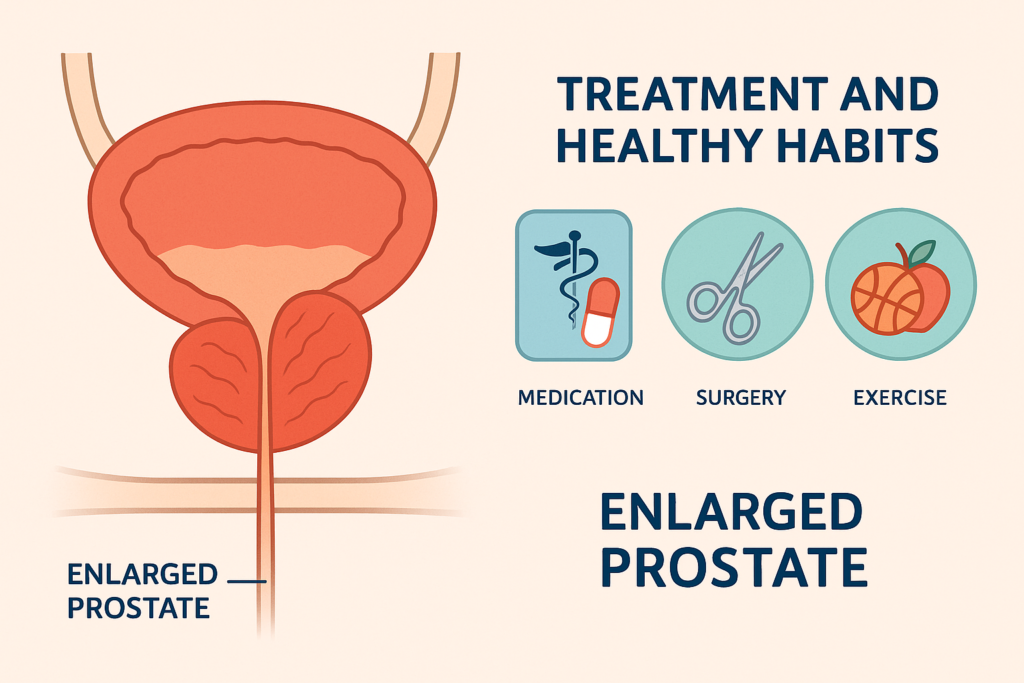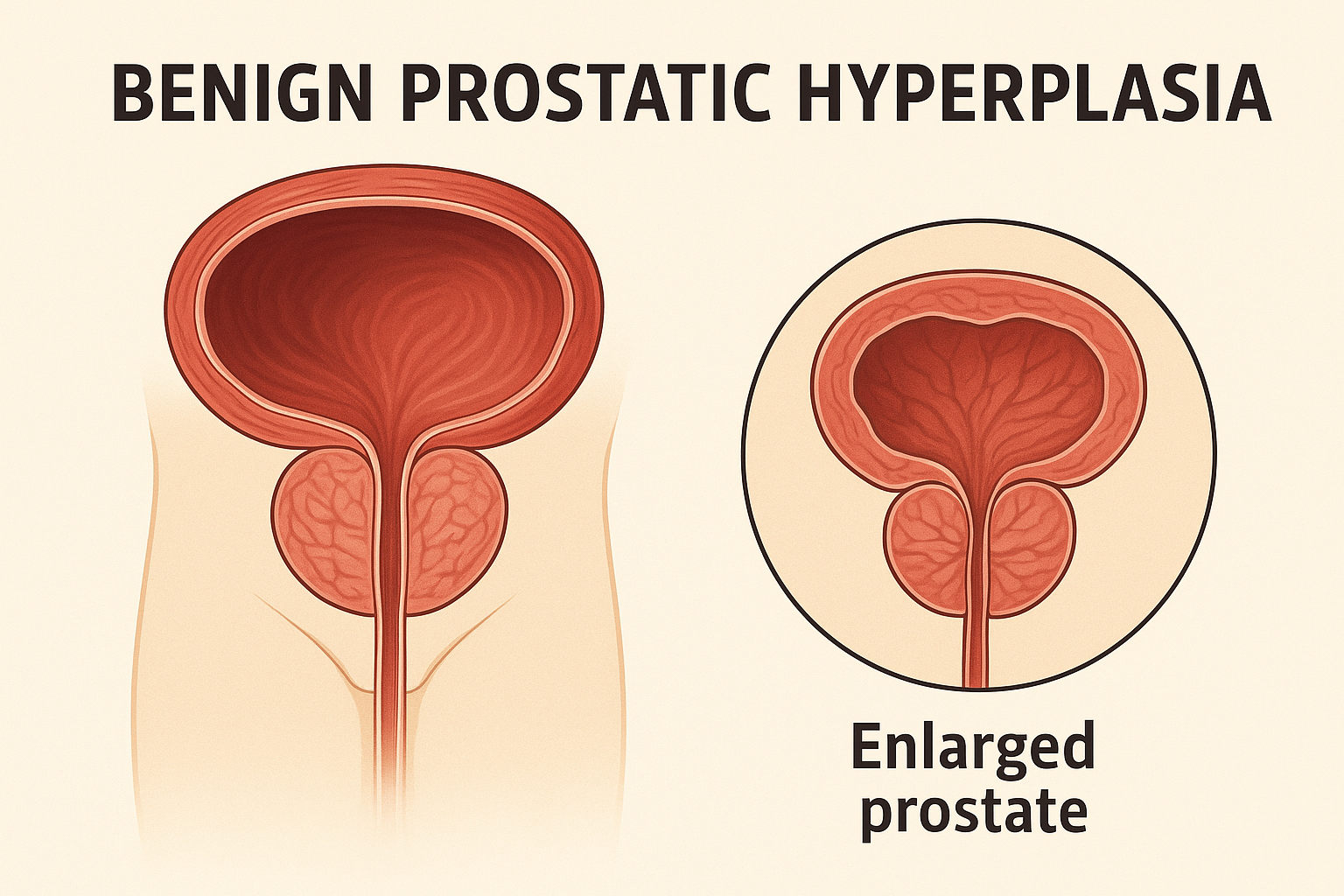Benign Prostatic Hyperplasia: Understanding Enlarged Prostate
Benign prostatic hyperplasia is the main cause of prostate enlargement in men over 50. This condition is not related to cancer but can significantly affect quality of life due to the urinary symptoms it causes. As men age, the prostate gland commonly enlarges, compressing the urethra and obstructing normal urine flow.
The term “benign” means there is no malignancy, but the issue should not be ignored. Medical monitoring is essential to avoid complications and maintain quality of life.
What is Benign Prostatic Hyperplasia (BPH)?
BPH is the non-cancerous growth of the prostate, a gland that is part of the male reproductive system. Its main function is to produce part of the seminal fluid. Over time, prostate cells multiply, leading to organ enlargement and urethral narrowing.
This natural process is driven by hormonal influence, particularly the action of dihydrotestosterone (DHT), a derivative of testosterone. When hormone levels become imbalanced with age, the prostate tends to grow.
Common Symptoms of Benign Prostatic Hyperplasia
The most frequent symptoms of BPH involve urinary changes that can disrupt sleep and daily activities.
Main symptoms include:
- Difficulty starting urination
- Weak or interrupted urine stream
- Urgency to urinate
- Frequent urination, especially at night (nocturia)
- Feeling of incomplete bladder emptying
- Dribbling at the end of urination
Symptoms vary from person to person and usually worsen over time. In severe cases, acute urinary retention may occur, requiring immediate medical intervention.
Causes and Risk Factors of Benign Prostatic Hyperplasia
Benign prostatic hyperplasia is directly associated with male aging and hormonal changes. However, several factors may increase the risk of developing the condition.
Key causes and risk factors:
- Older age: Men over 50 have a higher chance of developing BPH.
- Hormonal imbalance: Increased conversion of testosterone to DHT stimulates prostate growth.
- Family history: Having first-degree relatives with BPH increases risk.
- Sedentary lifestyle: Lack of physical activity contributes to prostate enlargement.
- Obesity: Linked to hormonal changes and increased inflammation.
- Chronic diseases: Type 2 diabetes and cardiovascular diseases are associated with higher BPH incidence.
Even with these risk factors, not all men will develop BPH. Ongoing medical care remains crucial.
How BPH is Diagnosed
Benign prostatic hyperplasia is diagnosed clinically, based on symptoms and confirmed with additional tests.
Key diagnostic methods:
- Digital rectal exam: Assesses prostate size and texture.
- PSA blood test: Helps rule out prostate cancer.
- Urinalysis and uroflowmetry: Evaluate urinary flow and detect infections.
- Prostate ultrasound: Measures prostate volume and residual urine.
- IPSS questionnaire: Assesses the severity of urinary symptoms.
These tests help distinguish BPH from other conditions like prostatitis or cancer. Based on the results, doctors choose the most appropriate treatment.
Treatment Options for Benign Prostatic Hyperplasia

BPH treatment depends on symptom severity and its impact on the patient’s life. Mild cases may require only monitoring. More advanced cases call for medication, surgery, or complementary approaches.
1. Medication
- Alpha-blockers: Relax prostate and bladder muscles (e.g., tamsulosin).
- 5-alpha-reductase inhibitors: Reduce prostate size (e.g., finasteride, dutasteride).
- Herbal treatments: Saw palmetto extract may ease mild symptoms.
2. Surgery
- Transurethral resection of the prostate (TURP): Minimally invasive technique.
- Simple prostatectomy: Partial or complete prostate removal for very large prostates.
- Newer techniques: Laser vaporization or prostate artery embolization.
3. Natural and Complementary Approaches
- Regular physical activity
- Reducing caffeine and alcohol
- Avoiding liquids before bed
- Stress management techniques
Diet and Healthy Habits for BPH Control
A healthy diet plays a vital role in prostate health. Balanced nutrition helps control prostate growth and ease symptoms.
Foods that help:
- Cruciferous vegetables: Broccoli, cauliflower, cabbage
- Tomatoes: Rich in lycopene, a protective antioxidant
- Fatty fish: Salmon and sardines provide anti-inflammatory omega-3s
- Berries: Strawberries, blueberries, raspberries offer antioxidants
Foods to avoid:
- Processed meats and saturated fats
- Ultra-processed foods
- Excessive alcohol
- High salt and caffeine intake
Maintaining a healthy weight, avoiding smoking, and exercising regularly support overall prostate health.
BPH and Prostate Cancer: What’s the Difference?
Though both involve prostate enlargement, benign prostatic hyperplasia and prostate cancer are different conditions. BPH is non-cancerous growth. Prostate cancer is the uncontrolled multiplication of malignant cells.
Main differences:
- BPH: Central prostate growth, affects urinary flow
- Cancer: Usually starts in the outer prostate, often symptom-free in early stages
Even though BPH is not cancer, they may coexist. Regular exams like PSA and digital rectal exam are vital for early detection.
When to See a Urologist
Many men delay medical consultations out of fear or embarrassment. However, early diagnosis of benign prostatic hyperplasia ensures better outcomes.
Seek a urologist if you experience:
- Persistent difficulty urinating
- Frequent nighttime urination
- Weak or interrupted urine stream
- Feeling of incomplete bladder emptying
- Pain or burning during urination
- Blood in the urine
Myths and Facts About Enlarged Prostate
- Myth: All prostate enlargement is cancer
Fact: Most prostate growths are benign, like BPH. - Myth: BPH only affects elderly men
Fact: It’s more common after 50, but may occur earlier. - Myth: BPH causes impotence
Fact: BPH itself doesn’t cause erectile dysfunction, though some drugs may. - Myth: Diet has no effect on prostate health
Fact: Nutrition plays a direct role in BPH management and prevention.
Conclusion
Benign prostatic hyperplasia is common in aging men and can significantly impact quality of life. With early diagnosis, lifestyle changes, and proper treatment, symptoms can be controlled and complications avoided.
Prevention starts with proactive health habits, regular checkups, and timely medical guidance.
Recommended Reading
Did you know type 2 diabetes can be reversed naturally? Learn how changes in diet and lifestyle can transform your long-term health.
➡️ Read how to reverse type 2 diabetes naturally
Experiencing leg weakness? Some vitamins in excess may be harming your muscles. Discover which ones and how to protect yourself.
➡️ Check which vitamins may weaken your legs
Trusted External Source
To explore more about prostate health and up-to-date medical recommendations, visit the Brazilian Society of Urology (SBU).
➡️ Visit the SBU’s guide on benign prostatic hyperplasia


No responses yet